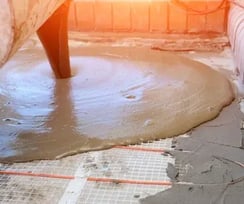Underfloor heating has surged in popularity over recent years. It provides consistent warmth throughout the room and is more energy-efficient in achieving your desired temperature. If you're contemplating the installation of underfloor heating in your home or integrating it into your business, continue reading as this blog will delve into the important factors to consider when selecting a liquid screed and offer insights on maximising its effectiveness for a successful installation. Underfloor heating systems come in two primary varieties. The first type, hydronic or water-based, involves the circulation of warm water through a network of steel or PVC pipes laid out uniformly beneath the floor. The second type is electric underfloor heating, which relies on electric cables and is generally preferred for smaller areas like bathrooms.
When it comes to screeds for underfloor heating systems, you have two choices: dry screeds and liquid screeds. Dry screeds, a traditional favourite, are generally suited for smaller spaces. They are created by combining cement and sand with water and fibre additives to minimise the risk of cracking. Liquid screeds are either poured or pumped into place, effortlessly spreading to the required level on their own. They are predominantly utilised for larger industrial or commercial projects due to their higher cost compared to dry screeds. These innovative flooring solutions are composed of a premium blend of cement, sand, and water, resulting in a smoother, more fluid consistency that allows for easy pouring, eliminating the need for manual handling and laying. The process of applying liquid screed is remarkably efficient, thanks to the use of specialised screed pumps. Once poured, the screed effortlessly flows around the water pipes, ensuring there are no gaps whatsoever. This seamless coverage guarantees an even distribution of heat, eliminating any potential air pockets around the piping. For a more in depth explanation into the advanced technology behind flowing screed, explore our detailed blog post here.

Regardless of whether your project is commercial or residential, there are several crucial aspects to consider when choosing the appropriate screed for underfloor heating installation, including:
Thermal conductivity- For underfloor heating, it is essential to choose a screed that facilitates heat passing through at a fast rate. Many flowing screeds, due to their higher density, excel in thermal conductivity, enabling swift and efficient heating throughout the installed space. When planning an installation, it is crucial to consider the type of screed utilised to ensure sufficient space for thermal movement and the expansion of the pipes.
The drying time is another crucial factor to consider, especially if you're working within a tight schedule. A shorter drying period allows you to proceed with laying flooring and completing other essential tasks, such as electrical, plumbing, and carpentry work, without unnecessary delays. Traditional screeds typically require a drying period of 5-7 days, followed by a minimum of 28 days before the heating system can be activated. Furthermore, once the system is installed, it should initially be run at a low temperature to gradually warm the screed. This gradual heating assists in the curing process, ensuring the screed reaches its optimal strength before the system is brought to its full operational temperature. Flow screed is regarded as a quicker and more efficient alternative to traditional screeds. Its main advantage lies in its application method; it can be poured in one continuous process rather than in sections, significantly enhancing the speed of installation. Once poured, the screed naturally hardens and self-levels, providing a smooth, even surface. Remarkably, it is usually walkable within 24 to 48 hours post-installation, although it does require a longer curing period compared to traditional screeds.
Another critical consideration is the depth of the screed in relation to the underfloor heating pipes, as this impacts the efficiency of heat distribution post-installation. Traditional screed can be from 65mm to 75mm in thickness and needs to stay the same throughout to keep heat distribution the same. Flow screed can be installed slightly thinner, as little as 50mm.

Within our range at CES, we offer a diverse selection of screed pumps sourced from reputable brands like Euromair and Putzmeister. If you're on the hunt for a compact electric pump to test out that new liquid screed, why not consider exploring the Euromair MixPro 28 for optimal performance. For larger scale projects, the Euromair X-PRO D140 and D200 offer heavy-duty diesel machines that can handle the job with ease. Our team of specialists are on hand to assist you in selecting the perfect pump for your specific project requirements, so why not reach out to us for expert guidance? And when you’re ready to pump check out our tips for achieving great results with floor screed.



